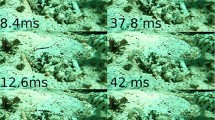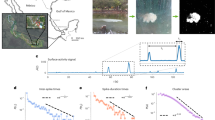Abstract.
The electric fish Gymnotus carapo emits brief (4 ms) electric pulses separated by much longer intervals of high regularity (coefficient of variation 0.01–0.02). Two main changes in the firing patterns of electric organ discharge were observed when two fish were placed together. (1) All fish pairs showed an increase in the frequency difference between the two fish, in comparison with the value observed in isolated fish, prior to the interaction. This change increased the number of beats per second between both discharge trains, i.e., the number of times per second that the higher rate discharge sweeps the lower rate one when displayed on an oscilloscope. (2) When the sweeping velocity fell below 2–3 sweeps/s, transient frequency increases were also observed in the electric organ discharge of the higher rate fish when they were about to discharge simultaneously. The contribution to jamming avoidance of these two changes was analyzed by comparing recordings of behavioral interactions with simulations produced by a computational model. The jamming effect of the firing of a conspecific located in the same tank was evaluated by counting the number of coincidences between both trains (occurrence of discharges of the two fish within 2 ms of one another). The number of coincidences was evaluated as a function of the sweeping velocity in both simulations (with and without transient frequency increases) and real fish. As the sweeping velocity increased, single coincidences increased slightly in simulations without transient frequency increases, whereas the successive coincidences (coincidences repeated in successive discharges) decreased abruptly. The simulation including transient frequency increases eliminated the successive coincidences and decreased the single ones. Only when the sweeping velocity was less than 2–3 sweeps/s, did transient frequency increases improve the coincidence-avoiding performance of the simulation. The number of coincidences observed in natural behavioral interactions for the different sweeping velocities coincided with the distributions obtained with the simulations. As successive coincidences are known to be more detrimental for electrolocation than single ones, the increase in the sweeping velocity may be considered a jamming avoidance strategy in Gymnotus carapo, in addition to the already described transient frequency increases.
Similar content being viewed by others
Author information
Authors and Affiliations
Additional information
Received: 2 June 1998 / Accepted in revised form: 18 November 1998
Rights and permissions
About this article
Cite this article
Capurro, A., Pakdaman, K., Perrone, R. et al. Analysis of the jamming avoidance response in the electric fish Gymnotus carapo . Biol Cybern 80, 269–283 (1999). https://doi.org/10.1007/s004220050524
Issue Date:
DOI: https://doi.org/10.1007/s004220050524




